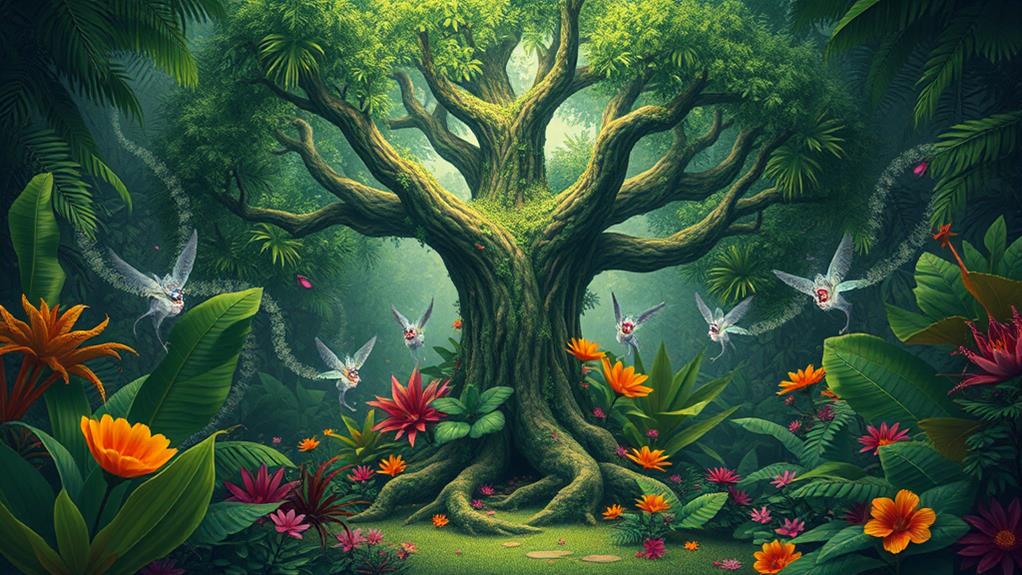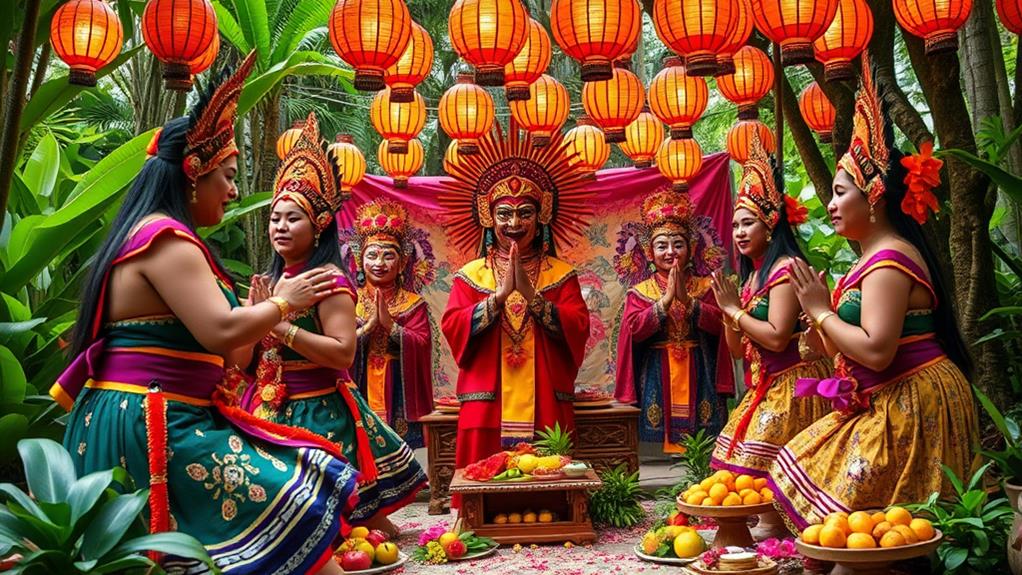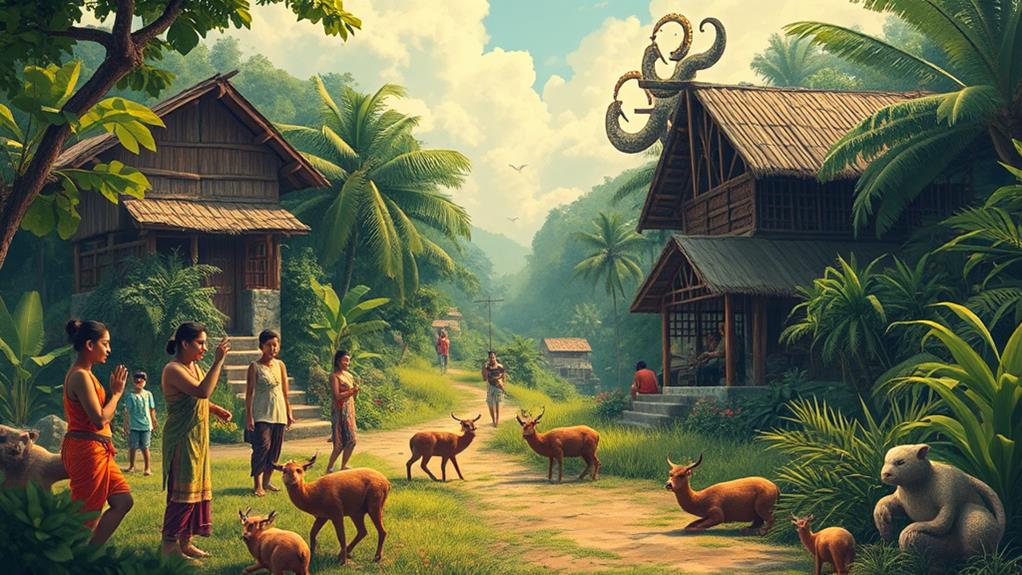Animism is a fundamental aspect of Filipino culture, connecting people to the spiritual energy of nature. This is evident in the reverence for Anito, where every element of the environment is believed to possess a soul.
In Pag-anito rituals, people honor ancestral spirits, emphasizing respect and harmony with nature.
The Ati-Atihan festival is a prime example of this heritage, blending indigenous beliefs with contemporary expressions.
This spiritual connection influences daily interactions with the environment and reinforces community bonds.
Understanding this relationship reveals insights into modern Filipino identity and environmental stewardship.
Overview of Animism

Animism in Filipino Culture
A Spirit-Filled World
In Filipino culture, animism is a belief system where every aspect of nature, such as trees, rivers, and mountains, is infused with spiritual energy. This energy is thought to be inhabited by numerous spiritual beings and nature deities, known as Anito, which significantly influence human affairs.
Rituals and Offerings
To maintain harmony and balance, rituals and offerings are necessary. Pag-anito, a ritual led by shamans, facilitates communication with these spirits. Shamans ensure that the connection between the human and spirit realms remains intact, promoting community cohesion.
Respect for Nature
The mariit belief system emphasizes respect for nature and its spirits, promoting environmental stewardship. This worldview intertwines spirituality with daily life, fostering a profound respect for the environment and a sense of belonging within the community.
Historical Significance
Before the arrival of Abrahamic religions during Spanish colonization, folk religions like animism constituted a significant portion of the population, shaping the Filipino worldview.
Understanding animism provides insight into how these beliefs continue to influence Filipino culture.
Spiritual Connection to Nature
Filipino Culture Embeds a Deep Spiritual Connection to Nature
In Filipino culture, every element of the environment is believed to possess a soul, fostering a profound respect for nature spirits and ancestral spirits that guide and protect communities. This animistic belief is reflected in the concept of Taglugar, which emphasizes the importance of recognizing spirit dwellers in specific natural locations.
Rituals are performed to honor these spirits and maintain harmony with the surroundings, preventing disasters and promoting a sense of community awareness.
Rituals Strengthen Spiritual Ties with the Environment
Rituals like Pag-anito allow shamans to communicate with ancestral and nature spirits, reinforcing the deep spiritual ties between people and their environment. This connection highlights the need to respect areas where nature spirits reside, ensuring communal safety.
Locals identify danger zones and take necessary precautions to avoid disturbing these areas.
Spirituality Fosters Sustainable Environmental Practices
The integration of spiritual beliefs into environmental protection efforts underscores the significance of this connection. Initiatives like the Mariit Wildlife and Conservation Park in Lambunao, Iloilo, illustrate how spirituality can foster sustainable practices and biodiversity conservation.
By recognizing the spiritual importance of nature, Filipinos are motivated to protect and preserve their environment.
The Spiritual Connection Shapes Filipino Culture and Environment
This spiritual connection to nature is vital in shaping Filipino culture and promoting a harmonious coexistence with the environment.
Rituals and Practices

Rituals and Practices in Filipino Culture
In Filipino culture, rituals and practices are essential expressions of deep-seated animistic beliefs that influence daily life. These rituals serve as bridges between the human and spirit worlds, ensuring harmony and balance.
Connecting with Ancestral Spirits
Pag-anito is a shaman-led séance that allows individuals to connect with ancestral spirits, reinforcing the belief in a parallel spirit world that significantly influences daily existence.
Respecting Nature
Filipinos participate in ceremonies that involve offerings to spirits associated with natural elements like thunder, the sun, and the moon, emphasizing the community's respect for nature.
Festivals and Celebrations
Events like the Ati-Atihan festival showcase how animism continues to thrive, blending indigenous beliefs with contemporary cultural celebrations, despite colonial histories.
The Role of Shamans
The role of shamans, often female or effeminate men known as babaylan, is crucial in these rituals. They act as mediators, guiding the community in healing and divination practices that connect individuals with the spirit world.
How Does Animism Impact the Religious Landscape in the Philippines?
Animism presents unique challenges in religious institutions in the Philippines. With many Filipinos integrating animistic beliefs into Catholicism, it can create tensions and conflicts within religious communities. This blending of animism with established religions impacts the religious landscape, leading to a complex and diverse spiritual environment.
Influence on Filipino Identity
Filipino Identity and Animism
Filipino identity is deeply rooted in animism, which is the belief that all things, including objects and natural elements, possess a spiritual essence. This belief system shapes various cultural practices, emphasizing respect for nature and spiritual beings.
Rituals and Community Bonds
Rituals like Pag-anito foster personal reflection and strengthen community bonds among diverse ethnic groups. These rituals honor spiritual beings and ancestral spirits, known as Anito, and emphasize the importance of family structures.
By communicating with ancestors, Filipinos maintain cultural continuity.
Syncretism and Festivals
Festivals such as Ati-Atihan showcase the syncretism of animistic traditions with Catholic practices. This blend of beliefs celebrates the vibrant tapestry of Filipino identity, resisting colonial influences.
Influence on Filipino Culture
In this rich cultural landscape, animism influences the way Filipinos relate to each other and their environment.
The reverence for nature and interconnectedness with spiritual beings create a unique identity that persists through generations.
Contemporary Relevance of Animism

Many Filipinos today still find resonance in animistic beliefs, seamlessly integrating them into their daily lives. These traditions shape various aspects of Philippine culture, from rituals honoring nature spirits to the presence of shamans, or babaylan, guiding communities through modern challenges while preserving folk beliefs.
Animism is still relevant today in three key ways:
Festivals like the Ati-Atihan celebrate ancestral and nature spirits, blending traditional practices with contemporary expressions. For instance, during this festival, participants dress up in colorful costumes and paint their faces to honor the spirits.
Environmental Conservation efforts are influenced by Mariit beliefs, which emphasize the spiritual significance of natural features. This promotes sustainable practices that respect the environment.
For example, in some Filipino communities, sacred forests are protected because they're believed to be inhabited by ancestral spirits.
Spiritual Guidance is provided by shamans, who continue to play a vital role in Filipino communities. They act as mediators between the spiritual and physical realms, helping individuals navigate life's complexities.
Shamans offer guidance on matters such as health, relationships, and livelihood, often using rituals and ceremonies to invoke the power of nature spirits.
This ongoing integration of animistic beliefs reflects a deep-rooted respect for nature and spiritual significance, enriching Filipino identity.
Questions and Answers
What Is Animism Culture in the Philippines?
Animism in the Philippines is a cultural practice that emphasizes spiritual connections with nature and reverence for ancestors. In this culture, communities engage in ritual practices to honor divine spirits, often within sacred spaces such as forests, mountains, or rivers. These rituals aim to maintain harmony and balance with the natural environment.
Folk narratives play a significant role in animism, highlighting the importance of totemic symbols. For example, the T'boli people of Mindanao believe in the symbolic power of the dreamcatcher, which is thought to ward off evil spirits and bring good fortune. These symbols illustrate the importance of cosmic balance and the interconnectedness of all living things.
Community rituals are an essential part of animist practices, allowing people to communicate with spiritual forces. During these rituals, spiritual leaders or shamans act as intermediaries between the physical and spiritual worlds. They perform ceremonies to ensure the well-being of the community, such as rituals for good harvests or healing ceremonies.
These practices showcase the enduring legacy of indigenous practices in contemporary Philippine society.
What Is Filipino Culture Influenced By?
Filipino culture is influenced by a mix of traditional practices, indigenous rituals, and foreign customs. These influences have shaped the country's unique cultural identity.
Traditional practices and indigenous rituals emphasize ancestral worship and spiritual connection. For example, the Ifugao people of northern Luzon practice a ritual called "hagabi," where they honor their ancestors through music, dance, and food offerings.
Similarly, the T'boli people of Mindanao have a ritual called "nefo," where they communicate with spirits through a medium.
Folk traditions and oral storytelling foster communal harmony. In the Philippines, folk tales and myths are passed down through generations, teaching important values such as respect for elders and the importance of community.
For instance, the legend of "Aswang," a supernatural being, teaches children about the dangers of disobeying their parents.
Sacred spaces play a vital role in cultural expressions. These spaces, such as ancestral homes and sacred mountains, allow individuals to honor their ancestors and connect with the divine.
The Ifugao people, for example, consider their rice terraces sacred because they believe the land was given to them by their ancestors.
Foreign customs have also shaped Filipino culture. The country was colonized by Spain, the United States, and Japan, introducing new customs and traditions.
For example, the Filipino celebration of Christmas is a mix of Spanish and American traditions, with decorations, gift-giving, and feasting.
What Is the Pre Hispanic Belief System in the Philippines?
The pre-Hispanic belief system in the Philippines was rooted in nature spirits and ancestral worship.
In this belief system, people honored nature deities through oral traditions and sacred rituals. These rituals fostered communal harmony and reinforced cultural identity. For example, agricultural rites ensured a bountiful harvest, while healing ceremonies promoted physical and spiritual well-being.
The connection between the people and their environment was vital, as it maintained balance and cooperation within the community and with nature.
Respecting nature spirits was crucial to the pre-Hispanic Filipinos, as it ensured the well-being of both the community and the natural world. This respect was reflected in their spiritual practices, which emphasized harmony with nature.
What Were the Beliefs of the Precolonial Philippines?
Ancestor Worship Was a Central Belief
In precolonial Philippines, ancestor worship was a core belief that shaped community identity. This involved honoring spirits of deceased ancestors, which was thought to maintain balance and harmony in the community.
Nature Spirits and Communal Rituals
People believed in nature spirits that inhabited the environment, and participated in communal rituals to celebrate agricultural practices and healing traditions. For example, rituals were performed to ensure a good harvest, and to seek healing from spirits believed to possess medicinal powers.
Sacred Objects and Divine Connection
Sacred objects, such as anting-anting (amulets) and агulo (ritual paraphernalia), were believed to link individuals to the divine. These objects were thought to possess spiritual power, and were used in rituals to communicate with the divine.
Oral Traditions and Cosmological Views
Oral traditions passed down stories that explained the world and its creation. These stories, known as sugidanon, described the origins of the universe, the creation of humans, and the role of gods and goddesses in shaping the world.
Hierarchy of Deities
A hierarchy of deities existed, with each deity associated with a specific aspect of life, such as Bathala, the supreme god, and Diwata, the goddess of fertility. This hierarchy reinforced the interconnectedness of life and spirituality in everyday existence.